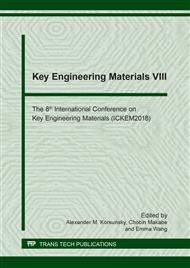p.32
p.36
p.43
p.50
p.57
p.63
p.68
p.74
p.81
Mechanochemical Assisted Modification of Parawood Microcrystalline Cellulose Using Silane Coupling Agent and their Composites Properties
Abstract:
Surface treated parawood microcrystalline cellulose (PW-MCC) performed under mechanochemical reaction using planetary ball milling at ambient temperature was used as a reinforcing material in polypropylene composites. Initially, PW-MCC was prepared by acid hydrolysis of parawood sawdust pulp. After that, PW-MCC was treated with vinyltrimethoxysilane at milling speed 400 rpm for 60 min. The surface composition from XPS indicated the existence of silicon atom on silane-treated PW-MCC. The thermal stability of PW-MCC was also improved and SEM micrograph revealed rough surface after modification reaction. The untreated PW-MCC and treated PW-MCC were applied to prepare polypropylene composites at 5-30 wt% loading content without a compatibilizer. The results demonstrated that silane-treated PW-MCC/PP composites enhanced tensile strength, thermal stability and water resistance of the composites.
Info:
Periodical:
Pages:
57-62
Citation:
Online since:
August 2018
Authors:
Price:
Сopyright:
© 2018 Trans Tech Publications Ltd. All Rights Reserved
Share:
Citation:


